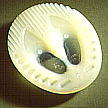P
Pink's lady
Guest
hi
Yann - I've had a quick look trying to find the site again with the picture of thermograph but I couldn't find it. I think it was a scientific paper attatched to one of the 'Barefoot' type web sites. I will have a look again later.
From the pictures, it showed heat loss, which was used as an indication of blood flow. In the shod foot, there would still have to be blood flow, however it obviouly wasn't as good. That was the basic point of the pictures, but I didn't read it thourghly enough to decided on it's validity of the results. If I can find it again, I'd like to have a proper read.
Presumably, it the blood flow and heat loss from unshod legs is greater, then they would loss heet more quickly(?)
RE ciculatory function of the hoof. THe hoof plays a great role in circulation of blood around the horses body. In the vet school they often talk of the horse as having 5 hearts - one in it's chest and one at the end of each leg.
As pressure is put onto the hoof the concave sole flattens and becomes convex and the hoof expands. This pulls blood down into the feet and legs. As the pressure is removed (they lift the leg) the hoof springs back into shape- pumping the blood back up the leg.
This pumping is absolutly essential in returning blood back to the heart - the extra thick, non-elastic skin of the legs prevents the legs from filling with blood, but the venous pressure(the pull of blood back to the heart) alone is not strong enough to push the blood back out of them . Thats what the feet are need for. if the feet were totally unable to expand and the soles unable to flatten (for example- they were in a concrete block), there would be basically no blood supply to the legs.
The shod hoof can still do this but only to a certain extent, as the expantion of the hoof is greatly hindered.
It would be really interesting to find out if horses that are unshod their entire life have less problems with arthritis. It has been shown that leg injuries heal much quicker in unshod horses.
I'm going to have a look again for the web site. I think it'll be quite interesting to read. I will post it up if I can find it.
Yann - I've had a quick look trying to find the site again with the picture of thermograph but I couldn't find it. I think it was a scientific paper attatched to one of the 'Barefoot' type web sites. I will have a look again later.
From the pictures, it showed heat loss, which was used as an indication of blood flow. In the shod foot, there would still have to be blood flow, however it obviouly wasn't as good. That was the basic point of the pictures, but I didn't read it thourghly enough to decided on it's validity of the results. If I can find it again, I'd like to have a proper read.
Presumably, it the blood flow and heat loss from unshod legs is greater, then they would loss heet more quickly(?)
RE ciculatory function of the hoof. THe hoof plays a great role in circulation of blood around the horses body. In the vet school they often talk of the horse as having 5 hearts - one in it's chest and one at the end of each leg.
As pressure is put onto the hoof the concave sole flattens and becomes convex and the hoof expands. This pulls blood down into the feet and legs. As the pressure is removed (they lift the leg) the hoof springs back into shape- pumping the blood back up the leg.
This pumping is absolutly essential in returning blood back to the heart - the extra thick, non-elastic skin of the legs prevents the legs from filling with blood, but the venous pressure(the pull of blood back to the heart) alone is not strong enough to push the blood back out of them . Thats what the feet are need for. if the feet were totally unable to expand and the soles unable to flatten (for example- they were in a concrete block), there would be basically no blood supply to the legs.
The shod hoof can still do this but only to a certain extent, as the expantion of the hoof is greatly hindered.
It would be really interesting to find out if horses that are unshod their entire life have less problems with arthritis. It has been shown that leg injuries heal much quicker in unshod horses.
I'm going to have a look again for the web site. I think it'll be quite interesting to read. I will post it up if I can find it.




